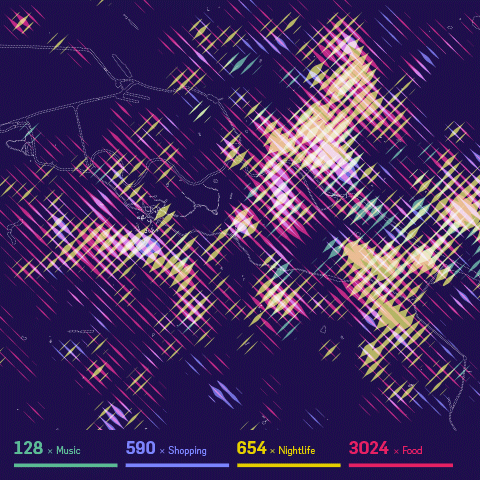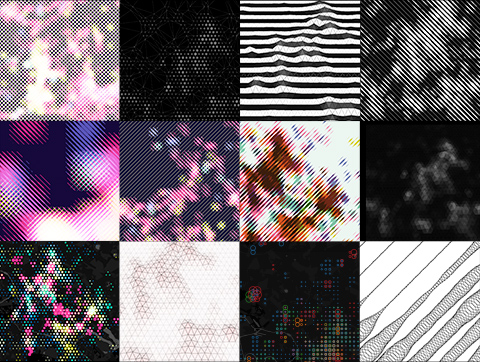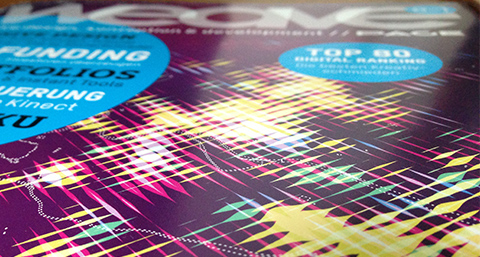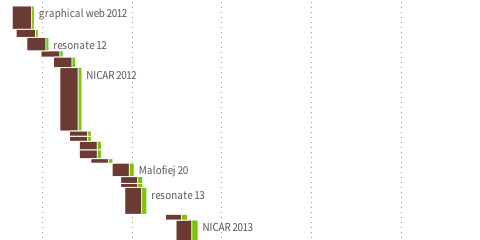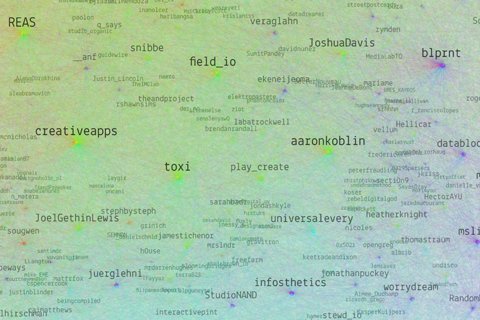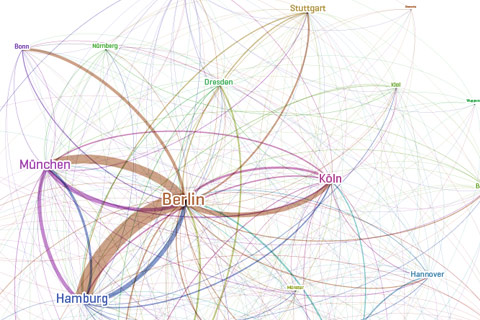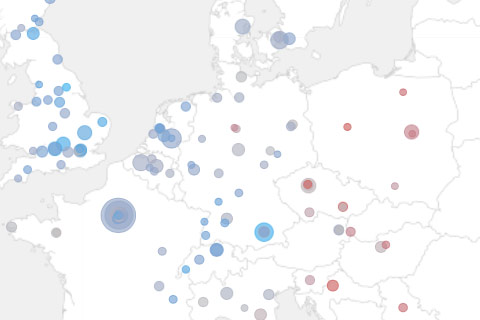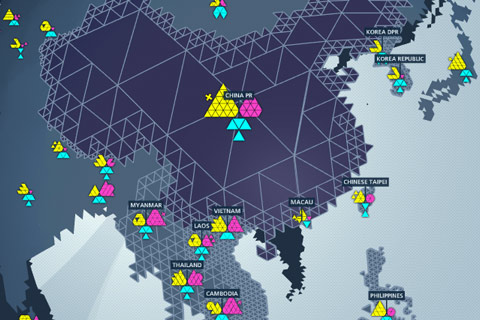Keynote at European Communication Summit
My speech from the summit. No big surprises for long-time followers, but a good summary overall, I guess. Also, I wear a suit!
Stadtbilder — mapping the digital shape of cities
Stadtbilder (“city images”) is a new little side project of mine — an attempt to map the digital shape of cities. I am increasingly fascinated by the idea of mapping the “real world” — life and culture as opposed to just physical infrastructure — and when I learned about the really deep datasets Georgi from Uberblic had been collecting, I just had to work with the data.
The maps show an overlay of all the digitally marked “hotspots” in a city, such as restaurant, hotels, clubs, etc. collected from different service like yelp, or foursquare. What they don’t show are the streets, the railroads, the buildings. I wanted to to portray the living parts of the cities as opposed to the technical/physical infrastructure you usually see on maps.The only exception are the rivers and lakes, because I felt they help a lot in orienting on these fairly abstract maps.
While the designs are meant to be printed, as a digital companion, the website helps you decipher the posters by providing a little map overlay on click. If you are interested in a print, please sign up to be notified when prints are available — I still need to figure out the precise logistics. (Let me know if you know of a high-quality poster printing and shipping service a la imagekind which can also ship from EU/worldwide..)
For now I settled on the three main German cities, because they have very different characteristics, and I know them very well. But I might be convinced to do other city editions as well :)
Here are some process shots!
It took me a while to figure out how to overlay these four different heatmaps on top of each other. I experimented with 3D manifolds, different dot patterns, small multiples, etc. etc. In the end, I am really happy with the solution I came up with, as combining always two of them in one stroke direction allows to decipher all of the dimensions, and just by looking at stroke width and brightness (if the two overlap), no need to do “color mixing reverse engineering” in your head, which is pretty much impossible anyways. The downside of this approach is obviously a low spatial resolution.
How does it work technically?
I first query the Uberblic API (not public yet, sorry ;) for the scores in the different categories by marching through a hexagonal grid.
From the values, I first draw fairly blurry heatmaps in processing:
I then walk over these heatmaps pixel by pixel in diagonal lines, and draw on a new canvas a line whose stroke corresponds to the brightness of the pixel on each step:
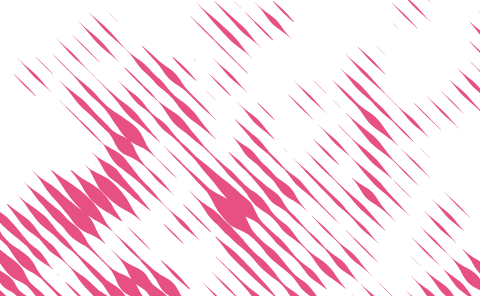
and then I merge and simplify these images in Illustrator. That’s it!
In other news, the Berlin version made it to the cover of WEAVE magazine already (but it should be noted that for this use case, the background was tweaked more into a blueberry tone, the original is way more violet):
If you find this project interesting, Flowingcity hosts a collection many more projects in this direction.
Anyways, let me know what you think of it!
Update: Prints are now available!
Interview for Nathan Yau’s new book “Data Points”
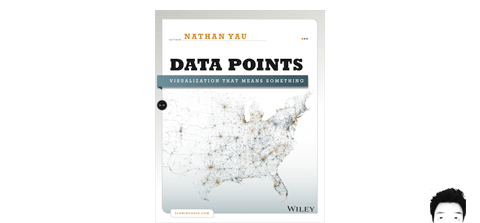
Nathan Yau‘s new book “Data Points” is out, and while I am still waiting for a copy, here is already a short contribution I made – a few paragraphs of bla:
Nathan Yau: With client work, you must hear “innovative”, “compelling”, and
“engaging” often. Personally, I get a lot of this, and potential clients often don’t have data to work with. What makes a project interesting to you and worth your time?
Moritz Stefaner: In hindsight, the most satisfying projects for me were the ones, where the client or project partners were able to follow me in exploring, questioning, and extending the original data basis and project, sometimes going far away from the original project idea. Some ideas sound really good in the beginning, but turn out bland or much too complicated once executed with real data. Other ideas sound boring beforehand, but become exciting in a specific context. And other ideas you just develop by getting inspired from the data material itself. So, I realize this approach is a lot about trust and also flexibility on side of the client, but is the only way to get your visualization on point, ultimately.
NY: For people like us, the data is interesting as a CSV file, but most
don’t get that luxury. What role does aesthetics play in making data
interesting to a wider audience? What about truth? (You are after all,
the truth and beauty operator :).
MS: I honestly hope, and sometimes think, that the playfulness and organic nature of some of my visualizations does actually get people excited about a topic they would not have been interested in beforehand. I do like to dig in data and be a little “data detective” myself, and if my work can contribute to getting more people excited about querying and questioning data, and, most importantly, come up with new questions to ask, than I am happy :) Aesthetics and appeal are of course a big part of the equation here, besides, of course, relevance of the information presented and truthfulness of the representation. But to me, aesthetics is very little about “decoration” – in my world, a clearly pronounced, rigorous, characteristic, “on point” representation of data lets the inner beauty of a compelling data set shine, instead of trying to “sex up” bland lists of facts.
NY: When getting started with visualization, everyone seems to want to know
the “rules” of turning data into geometry. Are there any rules?
MS: There are no hard rules, but, as in any skill-based profession, there are some things that work better than others, and as for any cultural activity, you are not acting in the void, but in an established set of conventions, expectations and common knowledge. In my experience, great works are not strictly adhering to “the rules”, but, at the same time, are very sensitive to these two types of contexts, and are able to refer to, and sometimes even play with them.
NY: What’s the first thing you do when you have your data and get started on
a project?
MS: Get a coffee, put on a DJ set, fire up Tableau and or Gephi, and Sublime Text for Python and data massaging and plot the sh*t out of the data. Then inspect, take a day to do something else, and follow up on the interesting perspectives. To continue, I might transform the existing data, get some new data, or take one of the interesting, but still very generic views and start to tailor it more to the specific issue at hand.
—
Looking forward to having a copy of the book in my hands! And thanks, Nathan!
—
Btw, a few weeks ago, iCharts interviewed me, too. Good times!
Gender balance visualization
So, I made this thing on how many women speakers we have on stage at the type of conferences I like to go to. Personally, I think our field is probably already quite grown-up in respect of diversity and balance, but I think we could still do much better. I hope my small data collection and visualization helps a bit for organizers to reflect where they would like to land on my x-axis :) Relatedly, if somebody has good intentions, but trouble finding good female speakers, drop me a line, I know plenty.
“Weltbilder” master course
This semester, I taught a master course on information visualization at HfK Bremen. It was quite fun and I think I was able improve a bit on the teaching side compared to the first full course I taught two years ago.
The topic was “Weltbilder” – “World views” which has become sort of a theme for my work lately. Here are the introductory slides and reference projects:
The course took place on 8 full days over the course of four weeks in February and March 2013. Overall, I had more than 20 students in the course (although some were only listening in without handing in a final project). The first few sessions were partly filled with me teaching basic craftmanship (slides—30MB) and establishing context, while the students gave presentations on some of my favorite scientific papers and articles (dropbox) and practitioners (such as Nathalie Miebach, Stefanie Posavec, Density Design, Santiago Ortiz, Nicholas Felton, Periscopic, Stamen, Ben Fry, Martin Wattenberg & Fernanda Viegas and the NYT graphics desk). We also had a few practical exercises on drawing family trees and fixing broken charts.
The second half of the course was much concerned with the student’s projects, and I did mostly 1:1 consultations. You can find a few of the final projects here. I like how the course results reflect the diversity of the students themselves – we had artists, computer scientists, journalists, people from humanities – quite a mixed bunch. Overall, I am quite happy with how things worked out and hope I could excite a few of my students to keep doing things in this field :)
Here are two of my favorite projects:
but in sum, they were all pretty nice in one way or the other :) Here’s the gallery
Look ma, no story!
Storytelling has been one of the big buzzwords in data visualization the last year. By now, there are even whole conferences about the topic and I heard even some podcasts carry the word in their name :D
So, one could be tempted to think that storytelling is the magical ingredient to turn boring charts into killer visuals, make the blind see and save the world at large.
But, as so often, the pure and simple truth is rarely pure and never simple.
In fact, some of my favorite visualizations have no story to them.
Look at the legendary map of the market. A fantastic tool to understand the state of the stock market at one glance.
Consider Aaron Koblin’s Flight Patterns.
The brilliant map of optimal tic-tac-toe moves by xkcd.
And so on.
Tools have no stories to them. Tools can reveal stories, help us tell stories, but they are neither the story itself nor the storyteller.
Portraits have no story to them either. Like a photo portrait of a person, a visualization portrait of a data set can allow you to capture many facets of a bigger whole, but there is not a single story there, either.
Let us not forget about these important genres. There is more to information visualization than punchlines.
—
Update: After a few twitter discussions, here is a clarification: I argue against the often heard claim “every good visualization tells a story”. I would agree that, in a loose reading of the word, you could say that some of the above visualizations “reveal stories” or might “trigger stories” in the viewer’s mind.
Resonet
Resonet is an attempt to map the twitter community around the resonate festival, using a technique similar to the vizosphere I made earlier. This time around, I used a zoomable SVG map, which makes text labels searchable. Make sure to also check out the data files and analysis, and feel free to remix the data!
Where people move in Germany
A quick diversion based on Bing search results for the phrase “von X nach Y gezogen” (“moved from X to Y”) applied to the top 30 German cities.
Made with Gephi and pattern.py
Mapping research excellence
Together with Lutz Bornmann, Rüdiger Mutz and Felix de Moya Anegon, I have been looking into which institutions (universities or research-focused institutions) are most active in different subject areas of science and which have published the most excellent papers. Based on my colleagues data analysis, we produced a small web application which allows to browse and explore the data set. The application is password protected, so you will need to end an email to password-request at excellencemapping.net to request access.
FIFA Development Globe
We finally launched the FIFA Development Globe, a project that has been in the making over the whole year. High fives and congrats to my fellow colleagues at Medienfabrik, Studio NAND, and Jens Franke. It was great to collaborate with you.
